By Lucy Komisar
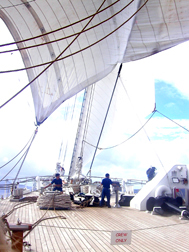
It‘s a shimmering sunny morning in the Caribbean, a night‘s voyage out of Antigua, and we‘re lounging on the Lido deck of the elegant Sea Cloud II. First Mate Hendrik Carlsson is explaining how to set sails and navigate a square rigger. Tall ships have square sales and are therefore called square riggers. We‘ve been given diagrams and lists of the 24 sails so we can follow the drill as agile crewmen sprint up high poles. The real sailors among the guests and even neophytes love it!
Then the ship sets a course for Dominica and a guided rowboat tour on the mysterious, lushly verdant Indian River.
A journey on the Sea Cloud II is unforgettable! I sailed on the original Sea Cloud seven years ago. That is the famous 360-foot, four-masted barque built in 1931 for cereal heiress Marjorie Merriweather Post by her second husband, Wall Street mogul E. F. Hutton.
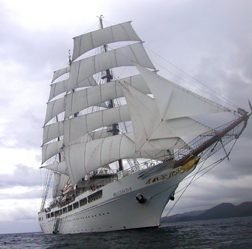
This sister ship, also a stunner, was constructed in 2001 by a German company and faithfully copies the original style, with dark mahogany, rosewood and teak interiors and tasteful, modish cabin furnishings. There‘s just a bit more room in the public spaces –four decks and dining room and an extra indoor lounge, designed to hold 94 passengers in 47 cabins.
It‘s not a private yacht, but there‘s a sense of intimacy on the Sea Cloud II. No feeling of being in a giant floating hotel. Passengers and crew are few enough so you get at least a nodding acquaintance with everyone. Couples and singles mix easily. And the crew takes scrupulous good care of everyone, from the bartender on deck remembering your drink to meticulous attention to the details of fine dining.
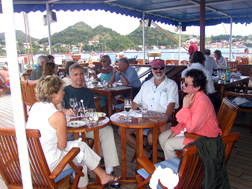
The welcome dinner was a sumptuous feast with smoked trout in aspic and white tomato mousse, lobster Cappuccino, passion fruit sorbet (to clear the palate), then roast beef on truffled cream of Savoy cabbage and potato pancake, and for the sweet, chocolate mille-feuille with mango ragout. Plus cheese for the European taste. And with dinner, South African Sauvignon Blanc-Semillon and Argentine Malbec.
All meals were served buffet style. Lunches were usually taken on deck and featured such dishes as fresh fish or glazed duck and crepe suzettes. One night there was an outdoor surf and turf barbecue with tuna, swordfish, mussels and prawns as well as steak, lamb, and crispy suckling pig.
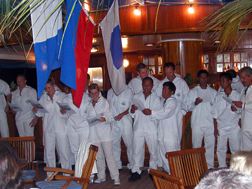
Evenings, people gathered on deck, ranged around the piano bar or gazing over the rail to the sea. One night, the crew in whites regaled us with sea shanties.
Could we move after all that food? Well, yes, and daytime outings tempted even the normally sedentary. For others there was always the fitness room, with exercise machines and sauna. Or just lazing in a deck chair with a book.
I loved the daily printed programs that we found on our beds on return from dinner, each giving a bit of the natural and political history of the place we would visit, as well as exact arrival and sailing times and ship-board events. The mood on board is casual and relaxed, even in the midst of luxury, and the nature of the trip draws people of interest and intelligence. This is not for people whose idea of a sea voyage is to sit inside a shipboard casino.
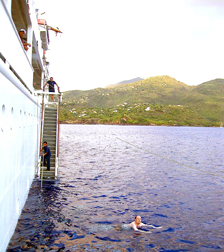
The first visit was to Dominica. Interesting that the briefing paper said, “Like in St Lucia, they lost the 1999 “Banana War” between their supporters in the UK and the big US fruit interests and so no longer get the guaranteed prices which they previously enjoyed as a member of the British Commonwealth.” Then: “The slow pace of development has helped maintain local ownership of the tourist sector, unlike the majority of West Indian islands where the majority of the hotels are foreign-owned and their profits leave the region.” I found the briefings refreshingly frank.
Sea Cloud Cruises President Christer Mörn, who normally works in Hamburg, was on board this trip, to check hands-on how the cruise went. An enthusiastic man of the sea in every respect, he was the first into the water when the crew let down the bathing dock after we anchored off Iles de Saintes.
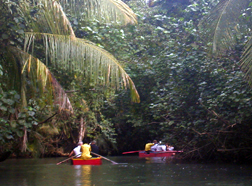
Dominica, known as the “nature island,” is a combination of mountainous terrain and lush rainforest. The tour takes small boats up the Indian River to see rare plants and, if you are lucky, a few species of indigenous parrots. After a mile of rowing by young men of the island, we stopped at a jungle bar that plied us with powerful drink! From there to a banana plantation. This is the island of Jean Rhys. I remember reading her novels at the start of the feminist movement, the most famous being “Wide Sargasso Sea,” which she wrote in 1966.
Back on board and sailing for St Lucia. The briefing paper told us that the island had been at various times English and French, which is why this member of the British Commonwealth has residents who speak both English and a French patois. They also lost the banana war! Independence from England came in 1978.

We approached from the sea rather than from the touristic north, and minivans took us to La Soufri¨re –the sulfur springs, the world‘s only drive-in volcano. Don‘t worry, the last eruption was in 1925, but the guide worked up as much drama as he could. Then to the Morne Coubaril Plantation, and finally to Diamond Falls Botanical Gardens, built on a hot spring with a waterfall and mineral baths.
Back on deck, there was an exhibition of knot tying and that night a wine-tasting dinner.
Tourist trekking is fascinating, but we were all ready for some time off to wander and go to the beach. That was on order for Terre de Haut, the Iles des Saintes, just south of Guadeloupe. The tender took us to the main town, Bourg (French for town!) and we dispersed to wander through the square, visit shops, and go on to Pompiere beach. Snorkles and masks had been piled on deck for anyone inclined to investigate the sea life. I did. It was satisfying, if not exceptional.

Finally, St Bart‘s. The capital, Gustavia is named for King Gustav of Sweden. The Swedes got the island in trade for French access to the Swedish warm water port of Goteborg. (Nobody seems to have asked the locals.) When sailing declined (not for tourists, just commercially!), the French came back. Their main occupations were rum smuggling, cattle raising and lobster fishing. Now add high-end tourism. This is big time shopping land with Cartier, Hermes and the like. (Here and on Iles des Saintes, Euros are required.)
The tender dropped us on the island, and we were on our own. My companion and I headed for the beach, which featured a trendy restaurant that virtually screamed “Paris chic.” Not to mention Paris prices. As a joke, the restaurant had set a giant bed on the beach.
I didn‘t go shopping there, though some more affluent souls did. I waited for the big market near the dock in St. John‘s, Antigua, the last port of call and the end of the voyage. (Best buys: bright shirts and shorts and the wonderful pareios that wrap around bathing suits but can double as scarves.)
My favorite remembrance, however, is a Sea Cloud t-shirt with a white outline of the magical ship on its sea of cotton blue.
Sea Cloud Cruises
32-40 North Dean Street
Englewood, NJ 07631
(888) 732-2568
in**@******ud.com
Booking: Sea Cloud Cruises sells individual passage and also charters the Sea Cloud and the Sea Cloud II to German and American travel operators and to groups such as the Smithsonian Institution, the American Museum of Natural History, college alumni associations and private companies for sails in the Caribbean from November to April and in the Mediterranean from May to October.
Our trip lasted five nights and four days, but most voyages are eight and seven.
Safety: There was a lifeboat drill the first day on board. Whenever we left the Sea Cloud, accompanying staff carried walkie-talkies to talk to the ship. A doctor was on board to deal with seasickness and minor illness or injuries. (I recommend taking ginger pills from the day before departure to ward off seasickness.)
Communications: The ship can make and receive satellite and cell phone calls and faxes, and you can send and receive emails. The island towns had internet cafes for which several of us made bee-lines.

